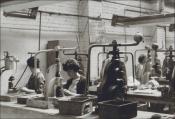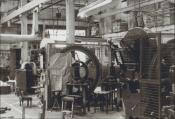Browse the interviews
Sorted by factory location
Caernarfon: Cockle factory
VN006 Dilys Wyn Jones, Corset factory, Caernarfon;Cockle factory, Caernarfon;Ferranti, Bangor
Dilys worked in the Corset Factory from the age of 15, straight from school. She worked on various lines, on different parts of the corsets. She enjoyed it there but on the whole found factory work repetative and boring. The factory was very basic: “It was a concrete floor and there was dust there, lime from the corsets. We had an X-ray every year. A man brought water in, in a watering can, he went around the place like that, watering the floor. There were windows like those on a greenhouse upstairs, and in the summer, it was boiling, you were being cooked alive.” She also worked later in other factories, such as the cockle factory in Caernarfon and Ferranti in Bangor.Caernarfon: Corset factory
VN006 Dilys Wyn Jones, Corset factory, Caernarfon;Cockle factory, Caernarfon;Ferranti, Bangor
Dilys worked in the Corset Factory from the age of 15, straight from school. She worked on various lines, on different parts of the corsets. She enjoyed it there but on the whole found factory work repetative and boring. The factory was very basic: “It was a concrete floor and there was dust there, lime from the corsets. We had an X-ray every year. A man brought water in, in a watering can, he went around the place like that, watering the floor. There were windows like those on a greenhouse upstairs, and in the summer, it was boiling, you were being cooked alive.” She also worked later in other factories, such as the cockle factory in Caernarfon and Ferranti in Bangor.Caernarfon: Corset Factory
VN012 Myfi Powell Jones, Corset Factory, Caernarfon
Myfi worked in the Corset Factory from the age of 15, immediately after leaving school. Her mother wanted her to go to college but Myfi liked sewing and was eager to get to work, so she and a friend went down to the factory to ask for work behind her mother's back. They both got the job but the managers had to separate them because they talked too much! Myfi began in the factory making ends, ie, finishing the corsets and then moved on to the stitching, where she excelled because she was very quick. She felt important as she earned one pound 10 shillings a week and could help support the family and pay the rent. There were 144 working there when she started in 1956 and this went down to under 50 aftewards, because fewer women wore corsets, and she was lucky to keep her job. The factory changed then to making bra slips. She married in 1959 and left to have her first child in 1960, returning to sewing work in Laura Ashley, Caernarfon, in the 1970s or 1980s.Caernarfon: Corset factory
VN014 Margaret Willams, Corset factory, Caernarfon
Margaret began in the Corset Factory at 15. She had no choice as her mother had told that once she was 15, she had to look for work. So she went down to the corset factory with her friend and they got a job. She earned £1.60 and if they worked overtime she got a shilling extra. Margaret gave her wages to her mother and she had two brothers who worked also. She was trained how to sew straight doing hems and bindings, and this training went on until a worker was able to handle a machine. She was very good at her job and worked as a supervisor at age 17 during the illness of the regular supervisor, Nansi Fawr. She did different jobs there and her sister Jeanette, who was blind, also worked there for five years. She liked working there even though it was very noisy with the machines. She said she'd go back now if it was with the same crew. Dinner time they used to get chips from a shop nearby and as Margaret worked near the door, the girls used to give her their orders and she'd go and fetch them. She was in the corset factory 6 years first time round, and went back for about six months four years after she married. After this she stayed at home to raise her children and when they went to school she did other jobs - cleaning and home help and finally working with the disabled.Caernarfon: Ferodo
VN021 Carol Morris, Ferodo, Caernarfon
After leaving school, Carol worked first in the corset factory then moved to Ferodo after a year because the pay was much better. In Ferodo, she was painting the company name and numbers on the break linings and stair treads. Ferodo was very big, with different sections and paths to walk round each of them. Workers couldn't go into some places unless they wore special clothing as it was dangerous. There were huge toilets for the men and women, not like the old fashioned Edwardian ones in the corset factory, and the workers had their own lockers, which was something very modern in the period. There were showers there too and on a Friday, the girls would bring in their going out clothes and wash their hair there and go out straight from work. There was a first aid room and a big canteen, the workers used to go for lunch and breaks in two sittings. It was a very friendly atmosphere, like a family. Carol enjoyed the work but left after a quarrel with the personnel manager when this man said something derogatory about her mother. She went to Ferranti to work but left soon after to get married and, later, returned to factory work in Laura Ashley in the 1980s.Part of this interview is available as an audio file

Caernarfon: James Kaylor Compacts
VN008 Mary Evans, James Kaylor Compacts, Caernarfon
Mary began in Kaylors when she was sixteen and she liked the work and the company. Her work was putting the polish on the compacts after they'd been dipped in acid, and putting the gems in them. Also she was making the tube that pushes the lipstick up. They could have rejects for free. She said factory work was an eye opener: “I was in my element there. Everyone was so close, there were 'rough and ready' girls but I liked them, I really liked then. I could listen to their stories, things I never got to hear at home, Good Lord!” The money was bad however - two pound something - and she left to go to Waterworths where the money was better. She met her husband in Waterworths left in 1961 to have a child but returned the following year. She left factory work in 1962 for office work to earn more money.VN007 Dafydd Llewelyn, James Kaylor Compacts, Caernarfon;Bernard Wardell, Caernarfon
Dafydd started as an apprentice tool setter in Kaylor Compacts on leaving school at the age of fifteen. He wanted to be a driver and only worked there a year before getting a job on the Co-op van. His main job was going round and changing the tools on the presses, and pushing the compacts into a tunnel where they were heated, and maintenance work, although he was suppose to be a tool-setter. He didn't like the job because of the way the foremen, two in particular, treated people, but he said his co-workers were great. When he walked down between the machines, the girls would pull his leg and call out things like “Do you want a thrill?” and he was only 15! The women looked after him. When he went to the canteen, there was a nice woman there who'd let him pay the next day if he didn't have enough on him. They didn't serve hot food, just snacks. He did work in another factory, Bernard Wardell, after leaving the compact factory but mainly did driving work thereafter.

VN022 Megan Owen, James Kaylor Compacts, Caernarfon
Megan worked for twenty years in the compact factory, starting at age 15. She hadn't left school properly when she started, but a friend who'd passed a scholarship to go to grammar school didn't want to go and this friend told Megan they were looking for people in the compact factory. So the two went down, got a job, and Megan had a row off her mother afterwards. She said on the first day they went in like schoolgirls, with little white socks and pony tails, giggling and not knowing what to do. The younger girls were put together in a room and taught how to put the little round piece that held the powder into the compacts and then the satin around it. Later she was moved onto to do other jobs, like printing, putting the designs onto the compacts with paint. Megan left for 12 years to raise her daughter, and then returned to the factory and stayed until it closed , c 1984.Part of this interview is available as an audio file




Caerphilly: Burlington
VSE034 Shirley Smith, Burlington, Caerphilly;Burry Son & Company Ltd, Treforest
Shirley studied in a commercial college before leaving at 17. She worked in a shop before joining Burry’s in 1957 (until 1982) – a textile factory – she was a shorthand typist in the office. They had an ancient machine to calculate the men’s wages. She discusses her wages, and the one woman supervisor’s wages – equal to the men’s. It was very noisy on the factory floor and the workers were on their feet all day. Poor conditions in the office; very hot in the factory all year. She names the factories open on the Treforest Esate at this time. Her boss died suddenly and the factory was taken over by Burlington Gloves. She was made redundant in 1989.Part of this interview is available as an audio file
